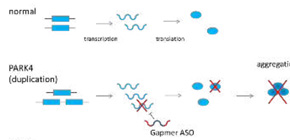
A positive step towards a cure for genetic Parkinson’s disease using nucleic acid medicines
Light shed on the development of medical treatment for the disease
Parkinson’s disease is a progressive neurodegenerative disorder, the second most common disorder after Alzheimer’s disease. There are medicines for improving the condition of individuals with the disorder, but no basic remedy for slowing its progression. That’s why many patients become bedridden, which has become a major social problem; thus, treatment methods for controlling the development of this disorder are being developed.
A group of researchers led by Professor MOCHIZUKI Hideki, Assistant Professor NAKAMORI Masayuki, and medical staff UEHARA Takuya at the Department of Neurology, Graduate School of Medicine, Osaka University, in a joint project with Professor OBIKA Satoshi at the Drug Innovation Center, Graduate School of Pharmaceutical Sciences, Osaka University, and Professor YOKOTA Takanori at the Department of Neurology and Neurological Science, Tokyo Medical and Dental University, verified in animal models that gapmer-type nucleic acid medicines containing modified Amido-bridged nucleic acid (AmNA) suppressed synuclein accumulation, improving the condition of genetic Parkinson’s disease.
Genetic Parkinson’s disease (PARK4) is caused by neuron death due to synuclein accumulation and aggregation. The excessive synuclein aggregation due to synuclein gene duplication leads to the onset of Parkinson’s disease.
This group proceeded with the development of treatment methods with the strategy to suppress excessive synuclein through nucleic acid medicines. In order to enhance suppression effects, this group chose the gapmer structure to demonstrate the strongest gene repression effects in a sequence with the highest inhibitory effect on synuclein by using AmNA, a specially modified nucleic acid with enzyme-resistant ability, as well as a sequence optimization program necessary for coding desired proteins.
On that basis, by administering gapmer-type nucleic acid medicine with AmNA to the cerebral ventricles of model mice with Parkinson’s disease, this group succeeded in suppressing synuclein accumulation in brain cells. In this study, the administration to the cerebral ventricles was performed in a way similar to the method used in real clinical practice, achieving the penetration of nucleic acid medicines into brain cells, demonstrating suppression effects on targets. For this reason, the clinical application of this group’s achievement is anticipated.
There was no basic remedy for delaying the onset and development of genetic Parkinson’s disease, so this group’s research results and methods will become epoch-making treatment methods. It is expected that this treatment method will be used not only for genetic Parkinson’s disease (PARK4), but also for sporadic Parkinson’s disease, which makes up the majority of Parkinson’s disease.
This research was presented by Assistant Prof. Nakamori in the 57 th Annual Meeting of the Japanese Society of Neurology on Friday, May 20, 2016.
Related link
- Department of Neurology, Graduate School of Medicine, Osaka University (link in English)

